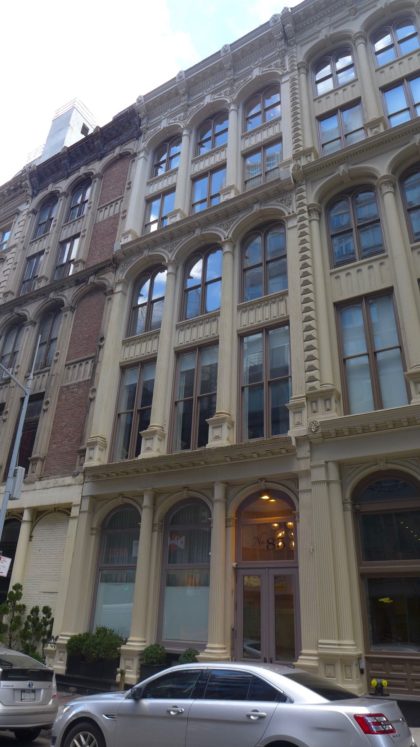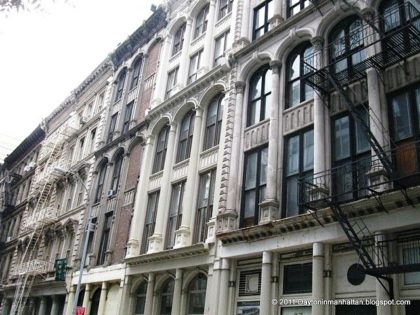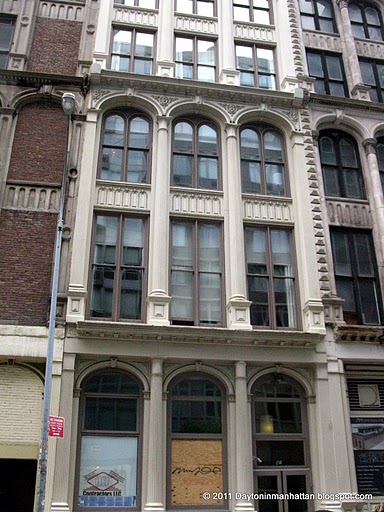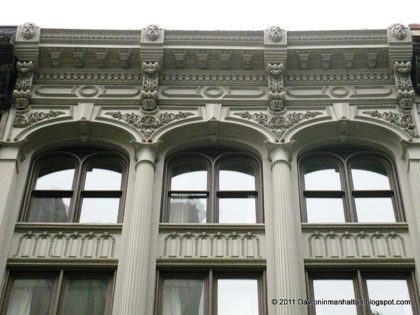The History of 85 Leonard
 Tom Miller, who writes about the history of Manhattan buildings at Daytonian in Manhattan, has allowed Tribeca Citizen to create a database of his Tribeca posts. If you enjoy these, and you will, then you should definitely check out his website, which also has write-ups about buildings all over the island. And don’t miss his book, Seeking New York: The Stories Behind the Historic Architecture of Manhattan—One Building at a Time.
Tom Miller, who writes about the history of Manhattan buildings at Daytonian in Manhattan, has allowed Tribeca Citizen to create a database of his Tribeca posts. If you enjoy these, and you will, then you should definitely check out his website, which also has write-ups about buildings all over the island. And don’t miss his book, Seeking New York: The Stories Behind the Historic Architecture of Manhattan—One Building at a Time.
··································
 During the 18th century, the land in what is now the Tribeca area was known as the Lispenard Meadows, owned by the wealthy Anthony Lispenard. As the city spread northward, streets were cut through the property, laid out by Effingham Embree. Lispenard named three of them for his sons: Thomas, Anthony, and Leonard.
During the 18th century, the land in what is now the Tribeca area was known as the Lispenard Meadows, owned by the wealthy Anthony Lispenard. As the city spread northward, streets were cut through the property, laid out by Effingham Embree. Lispenard named three of them for his sons: Thomas, Anthony, and Leonard.
In 1800, the streets were ceded to the city, and in 1806, the 27.5-foot-wide Leonard Street was widened to 50 feet. Before long, middle class residences and commercial buildings began lining the street. By the time of the Civil War, tall loft and retail buildings replaced them as the area developed into a dry goods and apparel district.
In the meantime, James Bogardus had established his New York cast iron foundry at Duane and Centre Streets in 1848. The main force in the development of cast iron as an architectural medium, Bogardus met with huge success with his quickly-built, relatively inexpensive and fire-proof construction. The finished sections were assembled on site and the façade was attached to the new structure. The innovative technique made large window openings and complicated ornamentation possible, and often mimicked the limestone or marble structures nearby.
 Bogardus’ cast iron structure (center) remarkably duplicated the stone buildings on either side.
Bogardus’ cast iron structure (center) remarkably duplicated the stone buildings on either side.
··································
In 1860 construction began on No. 85 Leonard Street. The dry goods firm of Kitchen, Montross and Wilcox commissioned Bogardus to design a loft building with retail space on the ground floor. The firm, owned by Ziba H. Kitchen, William Montross and Aaron P. Wilcox, had leased the land from the estate of Thomas Swords with the condition that they erect “a good and substantial store house.”
Completed in 1861, it was a five-story Italianate structure that astonishingly impersonated the stone buildings on either side. Two two-story tall sperm candle arcades (so named because the thin columns are similar to the candles manufactured from the oil of sperm whales) rise from a cornice above the ground floor and are repeated on the 4th and 5th floors. The cast iron allowed for more intricate ornamentation in the spandrels above the fifth floor windows than in the stone neighbors on either side.
 Kitchen, Montross & Wilcox ran its retail store in the building until around 1868, after which the ground floor continued to be the home of dry goods merchants.
Kitchen, Montross & Wilcox ran its retail store in the building until around 1868, after which the ground floor continued to be the home of dry goods merchants.
In 1883, the “commission merchants” Whitney & Matthews did business here. An inventory check that year revealed that around $2,400 worth of expensive silk was missing and Detective Sergeants Crowley and William Adams were determined to find the culprit.
On June 18 they arrested a clerk, James L. Sheerer when he was found pawning a roll of silk in a Sixth Avenue pawn shop. In his pockets, they found pawn tickets for 86 silk handkerchiefs and 50 pieces of silk. Another 4 pieces of silk and 96 silk handkerchiefs were discovered in his apartment on 20th Street near 6th Avenue. Whitney & Matthews found a new clerk.
Stevens Voisin was doing business on an upper floor in 1886 when he fled the country to escape debts. Although the exporter had about $25,000 due to him from outstanding accounts; he was unable to pay his creditors that were pressing him. Voisin apparently preferred Mexico to the Debtor’s Prison on Blackwell’s Island.
The ground floor, in the meantime, remained a dry goods store with Matthews, Blum & Vaughan occupying the space in 1887. Six years later, the Tappan Estate sold the building for about $102,000 to A. D. Juillard. Juillard was one of the main supporters of the Metroplitan Opera House. At the time the ground floor was renting for $5000 per year and a potential tenant offered $4,000 a year for the upper floors “in case an elevator is put in.”
 In 1897, while Fitzpatrick & Somers, agents for the Bridgeport Corset Company rented space here; Abraham Schwab, attempted to lobby for his favorite candidate Judge Van Wyck by stringing a banner reading “Republican Administration Means Official Extravagance” from the building. The former bridge commissioner’s banner stretched across the street to No. 88. Schwab quickly discovered that Leonard Street was Democratic stomping ground. His banner was cut down and two others promoting the Democratic Seth Low went up.
In 1897, while Fitzpatrick & Somers, agents for the Bridgeport Corset Company rented space here; Abraham Schwab, attempted to lobby for his favorite candidate Judge Van Wyck by stringing a banner reading “Republican Administration Means Official Extravagance” from the building. The former bridge commissioner’s banner stretched across the street to No. 88. Schwab quickly discovered that Leonard Street was Democratic stomping ground. His banner was cut down and two others promoting the Democratic Seth Low went up.
That same year the mail order firm of H. Smail did business from an upper floor selling “imported leg bands for pigeons and poultry. Numbered and lettered, all sizes.”
The dry goods firm of Ryan & McGraham was here at the turn of the century, followed by Thomas Michae and Cle, importers of dress goods in 1913.
A.D. Juillard’s daughter, Helen, put her late father’s real estate up for auction on February 10, 1920, including No. 85 Leonard. It was purchased by the Durham Hosiery Mills Company which installed its headquarters here. Two years later Lewis, Gerstman & Co., manufacturers of pajamas, were on an upper floor.
By the second half of the 20th century, the Tribeca neighborhood was the haunt of struggling artists who used the loft spaces for studios. No. 85 Leonard was purchased around 1974 by Joseph Salamon of RFR Promotional Fabrics, the same year it was designated a New York City Landmark. Salamon continued to rent the fourth floor as artists’ studios.
The original first floor storefront is amazingly intact. The wood-framed shop windows and the transoms remain. A treasure to Bogardus fans, the foundry mark is still clearly visible today: “James Bogardus, Originator and Patentee of Iron Buildings, Pat. May 7, 1856.”
··································
Photo credits from top: Tribeca Citizen; Alice Lum (3).













